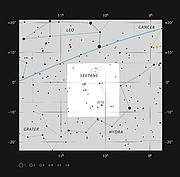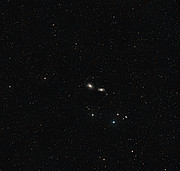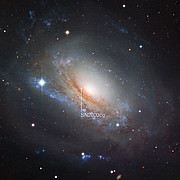Persbericht
Een vervormd galactisch paar
20 april 2011
Dit tweetal sterrenstelsels, vastgelegd met de Wide Field Imager van de 2,2-meter MPG/ESO-telescoop van de ESO-sterrenwacht op La Silla in Chili, vertoont enkele merkwaardige kenmerken, waaruit blijkt dat de twee elkaar dicht genoeg zijn genaderd om elkaars zwaartekrachtsinvloed te voelen. Door dit getouwtrek is de spiraalvorm van het ene stelsel, NGC 3169, verstoord en zijn de stofbanen van zijn begeleider, NGC 3166, verbrokkeld. Ondertussen kan het derde, kleinere stelsel NGC 3165, rechtsonder, het krachtenspel tussen zijn grote buren vanaf een plekje op de eerste rang volgen.
Dit groepje sterrenstelsels, dat zich op een afstand van ongeveer 70 miljoen lichtjaar in het sterrenbeeld Sextant bevindt, is in 1783 ontdekt door de Engelse astronoom William Herschel. De astronomen van nu schatten de afstand tussen NGC 3169 (links) en NGC 3166 (rechts) op slechts 50.000 lichtjaar. Daarmee is hun onderlinge afstand half zo klein als de middellijn van onze Melkweg: dermate gering dat de zwaartekracht een verwoestende uitwerking heeft op de galactische structuur.
Spiraalstelsels zoals NGC 3169 en NGC 3166 zijn doorgaans ordentelijke maalstromen van sterren en stofwolken die om een heldere kern draaien. Nabije ontmoetingen met andere zware objecten kunnen deze klassieke configuratie echter verstoren, wat vaak een voorbode is van het samensmelten van sterrenstelsels tot één groter stelsel. Zo ver is het bij NGC 3169 en NGC 3166 nog niet. Wel zijn de spiraalarmen van NGC 3169, die rijk zijn aan grote, jonge, blauwe sterren, uit elkaar getrokken en zijn grote hoeveelheden gloeiend gas uit zijn schijf ontsnapt. In het geval van NGC 3166 zijn de stofbanen die doorgaans de spiraalarmen omlijnen in wanorde gebracht. Anders dan zijn blauwere soortgenoot produceert NGC 3166 niet veel nieuwe sterren.
NGC 3169 onderscheidt zich ook door iets anders: de zwakke gele stip die door een sluier van donker stof links van het centrum van het stelsel heen schemert [1]. Deze lichtvlek is het overblijfsel van een supernova die in 2003 werd gedetecteerd en bekendstaat als SN 2003cg. Een supernova van dit soort, dat Type Ia wordt genoemd, ontstaat als een witte dwerg – een compacte, hete ster die het restant is van een middelgrote ster zoals onze zon – gas onttrekt aan een nabije begeleidende ster. Deze verse brandstof zorgt er uiteindelijk voor dat de witte dwerg op catastrofale wijze explodeert.
De hier getoonde foto van dit opmerkelijke galactische duo is gebaseerd op gegevens die door Igor Chekalin zijn geselecteerd in het kader van de ESO-fotowedstrijd Hidden Treasures 2010. Chekalin won de eerste prijs en deze foto haalde de op één na hoogste score van de bijna honderd inzendingen [2].
Noten
[1] Andere, veel opvallendere lichtpunten, zoals die aan het linker uiteinde van de spiraalarm die onderlangs de kern van NGC 3169 loopt, zijn sterren van de Melkweg die vanaf de aarde gezien toevallig op de voorgrond staan.
[2] ESO’s fotowedstrijd Hidden Treasures 2010 stelde amateurastronomen in de gelegenheid om de enorme ESO-archieven door te spitten op onvermoede astronomische juweeltjes die opgepoetst moesten worden. Meer informatie over Hidden Treasures is te vinden op http://www.eso.org/public/outreach/hiddentreasures/.
Meer informatie
ESO, de Europese Zuidelijke Sterrenwacht, is de belangrijkste intergouvernementele sterrenkundeorganisatie in Europa, en het meest productieve astronomische observatorium ter wereld. ESO wordt ondersteund door 15 landen: België, Brazilië, Denemarken, Duitsland, Finland, Frankrijk, Italië, Nederland, Oostenrijk, Portugal, Spanje, Tsjechië, het Verenigd Koninkrijk, Zweden en Zwitserland. ESO voert een ambitieus programma uit, gericht op het ontwerp, de bouw en het beheer van krachtige grondobservatoria die astronomen in staat stellen om belangrijke wetenschappelijke ontdekkingen te doen. ESO speelt ook een leidende rol bij het bevorderen en organiseren van samenwerking op sterrenkundig gebied. ESO beheert drie waarnemingslocaties van wereldklasse in Chili: La Silla, Paranal en Chajnantor. Op Paranal staat ESO’s Very Large Telescope (VLT), de meest geavanceerde optische sterrenwacht ter wereld. Ook is ESO de Europese partner van de revolutionaire telescoop ALMA, het grootste sterrenkundige project van dit moment. Daarnaast bereidt ESO momenteel de bouw voor van de 42-meter Europese Extremely Large optische/nabij-infrarood Telescoop (E-ELT), die ‘het grootste oog op de hemel’ ter wereld zal worden.
Contact
Richard Hook
ESO, La Silla, Paranal, E-ELT and Survey Telescopes Public Information Officer
Garching bei München, Germany
Tel: +49 89 3200 6655
Mobiel: +49 151 1537 3591
E-mail: rhook@eso.org
Marieke Baan (Perscontact Nederland)
ESO Science Outreach Network
en NOVA Informatie Centrum
Tel: +31(0)20-5257480
E-mail: eson-netherlands@eso.org
Over dit bericht
| Persberichten nr.: | eso1114nl |
| Naam: | NGC 3165, NGC 3169 |
| Type: | Local Universe : Galaxy : Type : Interacting |
| Facility: | MPG/ESO 2.2-metre telescope |
| Instruments: | WFI |
Our use of Cookies
We use cookies that are essential for accessing our websites and using our services. We also use cookies to analyse, measure and improve our websites’ performance, to enable content sharing via social media and to display media content hosted on third-party platforms.
ESO Cookies Policy
The European Organisation for Astronomical Research in the Southern Hemisphere (ESO) is the pre-eminent intergovernmental science and technology organisation in astronomy. It carries out an ambitious programme focused on the design, construction and operation of powerful ground-based observing facilities for astronomy.
This Cookies Policy is intended to provide clarity by outlining the cookies used on the ESO public websites, their functions, the options you have for controlling them, and the ways you can contact us for additional details.
What are cookies?
Cookies are small pieces of data stored on your device by websites you visit. They serve various purposes, such as remembering login credentials and preferences and enhance your browsing experience.
Categories of cookies we use
Essential cookies (always active): These cookies are strictly necessary for the proper functioning of our website. Without these cookies, the website cannot operate correctly, and certain services, such as logging in or accessing secure areas, may not be available; because they are essential for the website’s operation, they cannot be disabled.
Functional Cookies: These cookies enhance your browsing experience by enabling additional features and personalization, such as remembering your preferences and settings. While not strictly necessary for the website to function, they improve usability and convenience; these cookies are only placed if you provide your consent.
Analytics cookies: These cookies collect information about how visitors interact with our website, such as which pages are visited most often and how users navigate the site. This data helps us improve website performance, optimize content, and enhance the user experience; these cookies are only placed if you provide your consent. We use the following analytics cookies.
Matomo Cookies:
This website uses Matomo (formerly Piwik), an open source software which enables the statistical analysis of website visits. Matomo uses cookies (text files) which are saved on your computer and which allow us to analyze how you use our website. The website user information generated by the cookies will only be saved on the servers of our IT Department. We use this information to analyze www.eso.org visits and to prepare reports on website activities. These data will not be disclosed to third parties.
On behalf of ESO, Matomo will use this information for the purpose of evaluating your use of the website, compiling reports on website activity and providing other services relating to website activity and internet usage.
Matomo cookies settings:
Additional Third-party cookies on ESO websites: some of our pages display content from external providers, e.g. YouTube.
Such third-party services are outside of ESO control and may, at any time, change their terms of service, use of cookies, etc.
YouTube: Some videos on the ESO website are embedded from ESO’s official YouTube channel. We have enabled YouTube’s privacy-enhanced mode, meaning that no cookies are set unless the user actively clicks on the video to play it. Additionally, in this mode, YouTube does not store any personally identifiable cookie data for embedded video playbacks. For more details, please refer to YouTube’s embedding videos information page.
Cookies can also be classified based on the following elements.
Regarding the domain, there are:
- First-party cookies, set by the website you are currently visiting. They are stored by the same domain that you are browsing and are used to enhance your experience on that site;
- Third-party cookies, set by a domain other than the one you are currently visiting.
As for their duration, cookies can be:
- Browser-session cookies, which are deleted when the user closes the browser;
- Stored cookies, which stay on the user's device for a predetermined period of time.
How to manage cookies
Cookie settings: You can modify your cookie choices for the ESO webpages at any time by clicking on the link Cookie settings at the bottom of any page.
In your browser: If you wish to delete cookies or instruct your browser to delete or block cookies by default, please visit the help pages of your browser:
Please be aware that if you delete or decline cookies, certain functionalities of our website may be not be available and your browsing experience may be affected.
You can set most browsers to prevent any cookies being placed on your device, but you may then have to manually adjust some preferences every time you visit a site/page. And some services and functionalities may not work properly at all (e.g. profile logging-in, shop check out).
Updates to the ESO Cookies Policy
The ESO Cookies Policy may be subject to future updates, which will be made available on this page.
Additional information
For any queries related to cookies, please contact: pdprATesoDOTorg.
As ESO public webpages are managed by our Department of Communication, your questions will be dealt with the support of the said Department.





